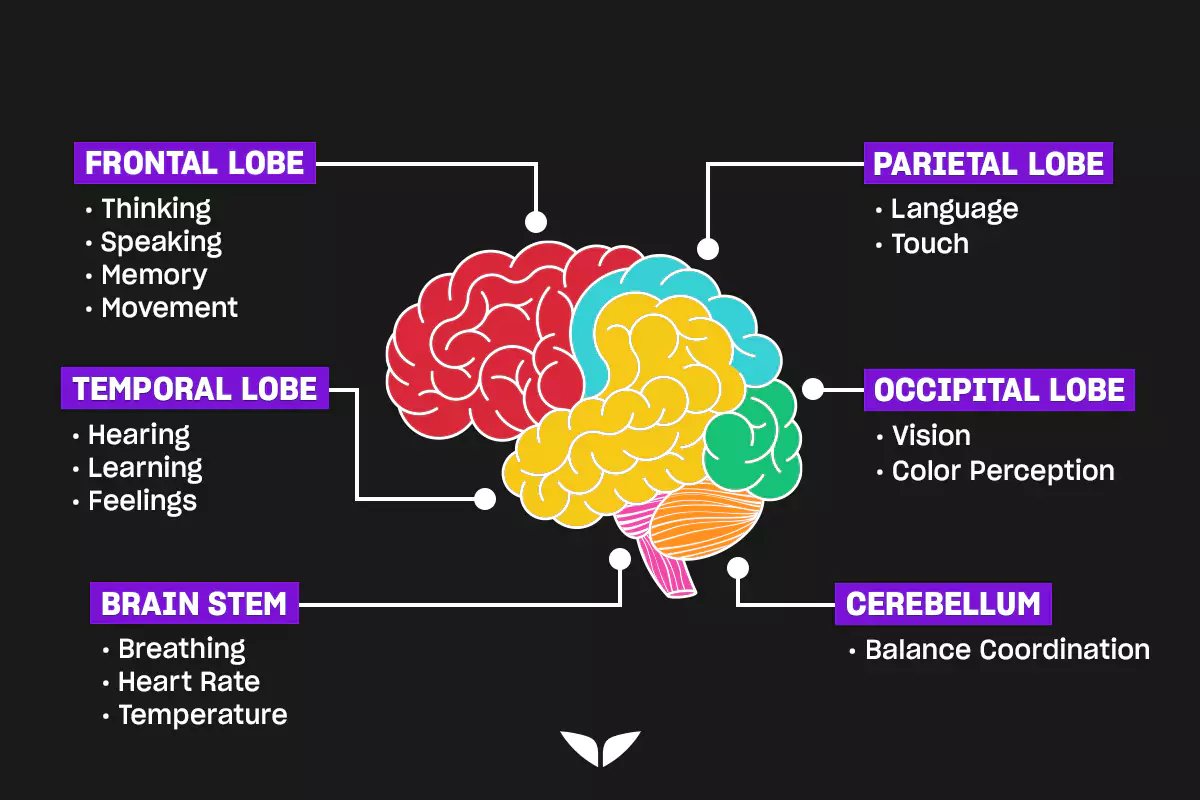Your body is a marvel. And one part that makes it so incredible is your brain — the organ that collects, stores, and processes information as well as controls the functions of all other organs in your body.
The four brain regions are like a committee of experts. Each part has its own specialization, yet they all work together to optimize your mind, body, and spirit.
“Your brain is like a massive supercomputer,” says Jim Kwik, world-renowned memory and brain coach and trainer of Mindvalley’s Superbrain Quest. And here’s where you can get insight into its operating system.
What Are the Regions of the Brain?
There are many parts to the brain. When it comes to the brain regions, though, there are four main parts:
- Cerebrum
- Cerebellum
- Brain stem
- Diencephalon
Each of them is in charge of different functions like thinking, memory, and movement.
The Cerebrum
The first and largest brain region is the cerebrum. It takes up the top part of the brain and accounts for 85% of its total volume.
This region of the brain comprises the outer layer called the cerebral cortex (gray matter) and the inner layer (white matter). The cerebral cortex consists of two cerebral hemispheres, each split into four sections called lobes.
What are the lobes of the brain?
There are four lobes of the brain: frontal, parietal, temporal, and occipital. Here’s a short summary of these brain parts and functions:
- Frontal lobe. Located at the front of the brain, the frontal lobe is involved in your everyday planning and self-management. This includes emotional regulation, higher planning, and problem-solving. Additionally, it helps with body movement, memory consolidation, speech production, and word comprehension.
- Parietal lobe. The middle part of the brain, the parietal lobe helps identify objects and understand where you are compared with the objects around you. It’s responsible for interpreting pain and touch in the body.
- Temporal lobe. This part of the cerebral cortex is located at the sides of the brain. The function of the left temporal lobe is to manage sight and sound processing and the right, to control visual memory and language comprehension.
- Occipital lobe. Located at the back part of the brain, the occipital lobe helps decode visual information — it processes the images it receives and sends them back to your eyes. It allows you to distinguish shapes as well as distances between the objects you see.
Here’s a visual on this part of the brain anatomy labeled:

What does the cerebrum do?
This region of the human brain has many functions, but it mostly deals with thinking. It also plays an important role in reasoning, learning, and feeling — both physical and emotional.
For example, let’s say you experience a chill when you step out into the cold without a jacket or cry when watching a sad movie. That’s your cerebrum at work.
Moreover, the cerebrum is also in charge of processing sensory information. Without it, you wouldn’t be able to hear or see.
The Cerebellum
Positioned under the back part of the cerebrum lies the cerebellum. This region of the brain is known as the “little brain” and takes up just 10% of the brain’s total volume.
It has two hemispheres, like the cerebral cortex. The outer part contains neurons and the inner part communicates with the cerebral cortex.
What does the cerebellum do?
The cerebellum is primarily in charge of movement and coordination.
To understand exactly what this brain region does, here’s a simple examination that doctors perform simply called the finger-to-nose test.
- The doctor would start by placing their finger just two feet away from your face.
- You are then asked to touch the tip of your nose with your index finger.
- Then, touch the tip of the doctor’s finger.
- You would do this as fast as possible, all while the doctor slowly moves their finger away from you.
This simple examination shows that the cerebellum is working properly to ensure hand-eye coordination. The doctor wants to confirm that your index fingers don’t miss their mark and end up on your chin or missing your hand completely.
The Brain Stem
While the cerebrum has multiple parts to it and the cerebellum has one, how many regions make up the brain stem? The answer is three.
This region of the brain consists of the midbrain, pons, and medulla oblongata. Together, they take up about 4% of the brain’s total volume.
What does the brain stem do?
Although they make up a small percentage of the brain’s volume, here’s what you should know about this particular brain structure and function:
- The midbrain. This part of the brainstem is located at the top. Its primary function is to regulate eye movement.
- The pons. Located above the medulla oblongata, the pons are primarily part of the brain that controls breathing as well as sleep regulation.
- The medulla. Located at the bottom of the stem, it helps control your cardiovascular and respiratory systems. In addition, this part of the brain is also responsible for various reflexive actions. Every time you cough, sneeze, or vomit, it’s your body acting on the impulses sent from the medulla.
The Diencephalon
The diencephalon is the smallest of the four brain sections. It’s tucked between the cerebrum and the brain stem and is, for the most part, hidden from view.
What does the diencephalon do?
Before sensory information reaches the cerebrum, it must first go through the diencephalon. As such, the main role of the diencephalon is to relay the information obtained by your senses across the brain.
What’s more, it also helps control your body’s endocrine and autonomic functions. It works in tandem with the cerebellum to support optimal motor function control.

5 Fun Facts About the Brain Regions: Frequently Asked Questions
The brain is a fascinating, yet complex organ in your body. It’s responsible for so many different functions in our body.
That’s why it’s incredibly important to keep it active. Here are a few interesting facts that demonstrate how powerful it is.
1. What regions of the brain are involved in sleep?
There are several structures of the brain that help with getting you to sleep. These, according to the National Institute of Neurological Disorders and Stroke, include:
- Hypothalamus
- Brain stem
- Thalamus
- Cerebral cortex
- Pineal gland
- Basal forebrain
- Amygdala
Together, they work to help you fall asleep and keep you in that state. Additionally, they help with arousal, sensing the light exposure and signaling your body to wake up.
2. What regions of the brain are involved in vision?
Most visual functions are mainly controlled by the occipital lobe. Specifically, the visual cortex, which is the area of the cerebral cortex that is located in the occipital lobe.
When you see something, that visual input goes from the eyes through the thalamus and then, into the visual cortex. Your occipital lobe processes that information and sends it to your eyes, allowing you to comprehend what you’re looking at.
3. Which regions of the brain regulate breathing and heart rate?
The function of breathing and heart rate goes to the brain stem. It acts as the messenger between the brain and other body parts.
Its three parts work together to help process information, move, and function. It regulates body functions that are, more often than not, automatic, like blood pressure, heart rhythm, breathing, and swallowing.
4. What regions of the brain are involved in memory?
Memory plays a fundamental role in life. And there are several regions of the brain involved in it:
- Amygdala: memory formation and regulating the emotional response to that memory
- Hippocampus: memory processing and where new memories are encoded
- Cerebellum: process procedural memories
- Prefrontal cortex: process and retain information
They work together to allow you to reflect on the past. With those experiences, these parts of the brain ensure it either stays in the past or be used as a learning tool to do and be better.
5. What regions of the brain are involved in speaking?
The frontal and temporal lobes are the regions of your brain that are primarily responsible for speech formation and understanding.
Science specifically points to an area in the frontal part of the brain’s left hemisphere called Broca’s area. It was named after French surgeon Paul Broca who, in 1861, found that the area plays a vital role in turning ideas and thoughts into spoken words.

Unleash Your Superbrain
Understanding your brain regions and how they work is the first step to understanding how to optimize your mental well-being. As Jim Kwik says, “We need to understand how our minds work, so we can work our minds better.”
The memory and brain coach also happens to be the trainer of Mindvalley’s Superbrain Quest, where you can master the process of unleashing your superhuman memory, focus, and learning speed. Just like Jim, world-class professionals, entrepreneurs, and Hollywood celebrities (hint: the X-Men).
When you unlock the free Mindvalley access, you’ll have access to the sample classes of each quest (including Superbrain), plus a library of guided meditations to listen to anytime you want. So here’s to a better you every day.
Welcome in.








